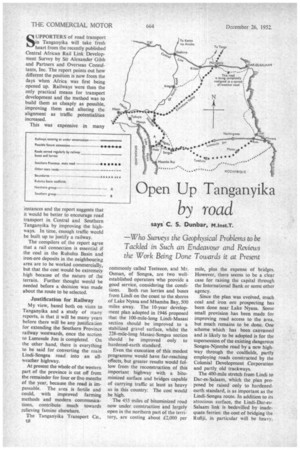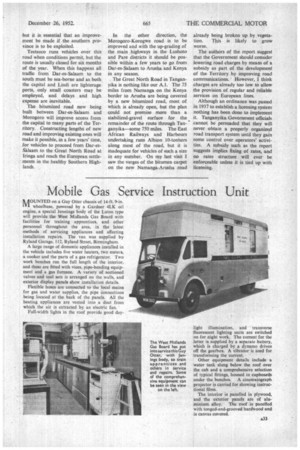Open Up Tanganyika
Page 42

Page 43

If you've noticed an error in this article please click here to report it so we can fix it.
by road
says C. S. Dunbar, M.Inst.T.
—Who Surveys the Geophysical Problems to be Tackled in Such an Endeavour and Reviews the Work Being Done Towards it at Present
SUPPORTERS of road transport in Tanganyika will take fresh heart from the recently published Central African Rail Link Development Survey by Sir Alexander Gibb and Partners and Overseas Consultants, Inc. The report points out how different the position is now from the days when Africa was first being opened up. Railways were then the only practical means for transport development and the method was to build them as cheaply as possible, improving them and altering the alignment as traffic potentialities increased.
This was expensive in many instances and the report suggests that it would be better to encourage road transport in Central and Southern Tanganyika by improving the highways. In time, enough traffic would be built up to justify a railway.
The compilers of the report agree that a rail connection is essential if the coal in the Ruhuhu Basin and iron-ore deposits in the neighbouring area are to be worked commercially, but that the cost would be extremely high because of the nature of the terrain. Further thought would be needed before a decision was made about the route to be selected.
Justification for Railway
My view, based both on visits to Tanganyika and a study of many reports, is that it will be many years before there will be any justification for extending the Southern Province railway westwards, once the section to Lumesule Juu is completed. On the other hand, there is everything to be said for converting the main Lindi-Songea road into an allweather highway.
At present the whole of the western part of the province is cut off from the remainder for four or five months of the year, because the road is impassable. The area is fertile and could, with improved farming methods and modern communications, contribute much towards relieving famine elsewhere.
The Tanganyika Transport Co., commonly called Teeteeco, and Mr. Osman, of Songea, are two wellestablished operators who provide a good service, considering the condi tions. Both run lorries and buses from Lindi on the coast to the shores of Lake Nyasa and Mbamba Bay, 500 miles away. The 10-year development plan adopted in 1946 proposed that the 100-mile-long Lindi-Masasi section should be improved to a stabilized gravel surface, whilst the 228-mile-long Masasi-Songea section should be improved only to hardened-earth standard.
Even the execution of this modest programme would have far-reaching effects, but greater results would follow from the reconstruction of this important highway with a bituminized surface and bridges capable of carrying traffic at least as heavy as in this country: The cost would be high.
The 455 miles of bituminized road now under construction and largely open in the northern part of the territory, are costing about £2,000 per
mile, plus the expense of bridges. However, there seems to be a clear case for raising the capital through the International Bank or some other agency.
Since the plan was evolved, much coal and iron ore prospecting has been done near Lake Nyasa. Some small provision has been made for improving road access to the area, but much remains to be done. One scheme which has been canvassed and is likely to be adopted is for the supersession of the existing dangerous Songea-Njombe road by a new highway through the coalfields, partly employing roads constructed by the Colonial Development Corporation and partly old trackways.
The 400-mile stretch from Lindi to Dar-es-Salaam, which the plan proposed be raised only to hardenedearth standard, is as important as the Lindi-Songea route. In addition to its atrocious surface, the Lindi-Dar-esSalaam link is bedevilled by inadequate ferries: the cost of bridging the Rufiji, in particular will be heavy, but it is essential that an improvement be made if the southern province is to be exploited.
Teeteeco runs vehicles over this road when conditions permit, but the route is usually closed for six months of the year. When this happens all traffic from Dar-es-Salaam to the south must be sea-borne and as both the capital and Lindi are lighterage ports, only small coasters may be employed, and delays and high expense are inevitable.
The bitumized road now being built between Dar-es-Salaam and Morogoro will improve access from the capital to many parts of the Territory. Constructing lengths of new road and improving existing ones will make it possible, in a few years' time, for vehicles to proceed from Dar-esSalaam to the Great North Road at Iringa and reach the European settle • rnents in the healthy Southern Highlands. In the other direction, the Morogoro-Korogwe road is to be improved and with the up-grading of the main highways in the Lushoto and Pare districts it should be possible within a few years to go from Dar-es-Salaam to Arusha and Kenya in any season.
. The Great North Road in Tanganyika is nothing like our A.1. The 75 miles from Namanga on the Kenya border to Arusha are being covered by a new bitumized road, most of which is already open, but the plan Gould not promise more than a stabilized-gravel surface for the remainder of the route through Tanganyika—some 750 miles. The East African Railways and Harbours undertaking runs Albion 10-tonhers along most of the road, but it is inadequate for vehicles of such a size in any number. On my last visit I saw the verges of the bitumen carpet on the new Namanga-Arusha road already being broken up by vegetation. This is likely to grow worse.
The authors of the report suggest that the Government should consider lowering road charges by means of a subsidy as part of the development of the Territory by improving road communications. However, I think charges are already too low to allow the provision of regular and reliable services on European lines.
Although an ordinance was passed in 1937 to establish a licensing system nothing has been done to implement it. Tanganyika Government officials cannot be persuaded that they will never obtain a properly organized road transport system until they gain some control over operators' activities. A subsidy such as the report suggests implies fixing of rates, and no rates structure will ever be enforceable unless it is tied up with licensing.












































































